Failure of the French Before Jamestown
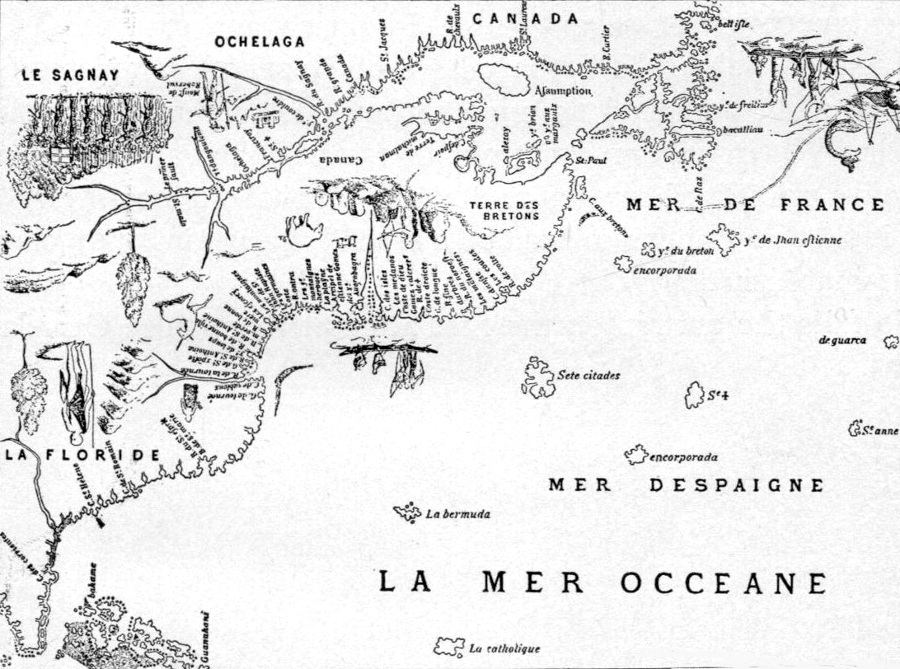
maps documenting early French exploration treated the southeastern corner of the North American continent as Spanish territory ("La Floride"), but asserted French claims to the St. Lawrence River valley
Source: Canada: the Empire of the North, Dauphin Map of Canada (by Jacques Cartier, c.1543)
The French claim to lands in North America was based on the Doctrine of Discovery, a European concept that allowed France to assert legal ownership of lands not occupied by Christians. The territory that became New France and later Canada may have been discovered by French fishermen in the year 1504, followed by the better-documented voyages of Jacques Cartier to the St. Lawrence River.1
French King Francis I financed explorations by Giovanni da Verrazzano to explore the coast of North America in 1524. To minimize the chance of creating a justification for military action, that expedition explored far north of the Spanish-controlled Caribbean. Verrazzano chose to stay rather far from the shore and missed the mouth of both the Chesapeake Bay and Delaware Bay. He did discover New York harbor, where the Verrazano Bridge (missing one "z") was named for him.
On the way north up the coastline, Verrazzano stopped at what may have been Cape Fear, Hatteras, and the Eastern Shore of Virginia/Maryland. He had the political good sense to name the land "Francesca" to honor his French king, Francis I. After Verrazzano saw water behind barrier islands, he was one of many who explored eastern North America and claimed to glimpse the Pacific Ocean:2
- We called it Annunciata from the day of arrival, and found there an isthmus one mile wide and about 200 miles long, in which we could see the eastern sea from the ship... This is doubtless the one which goes around the tip of India, China and Cathay.
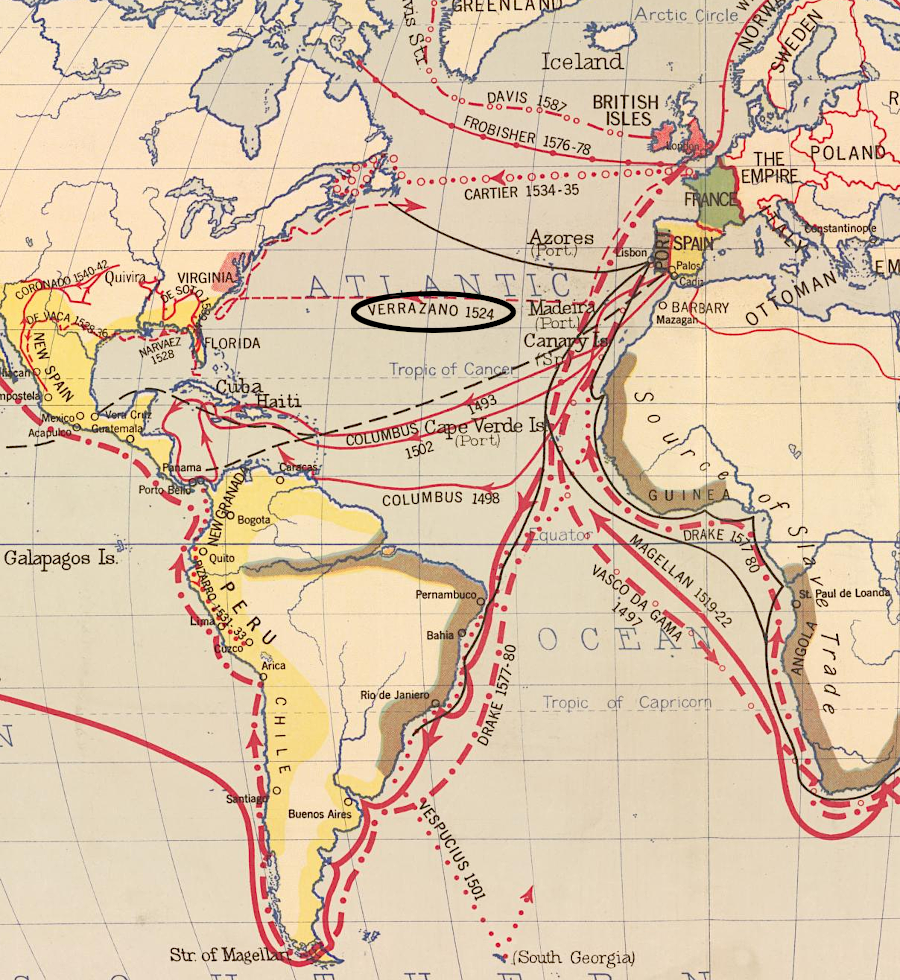
in 1524, Giovanni da Verrazzano sailed along the Atlantic Ocean shoreline of what later became the English colony of Virginia
Source: Library of Congress, World exploration to 1580 (Image 2, Hart-Bolton American history maps, 1917)
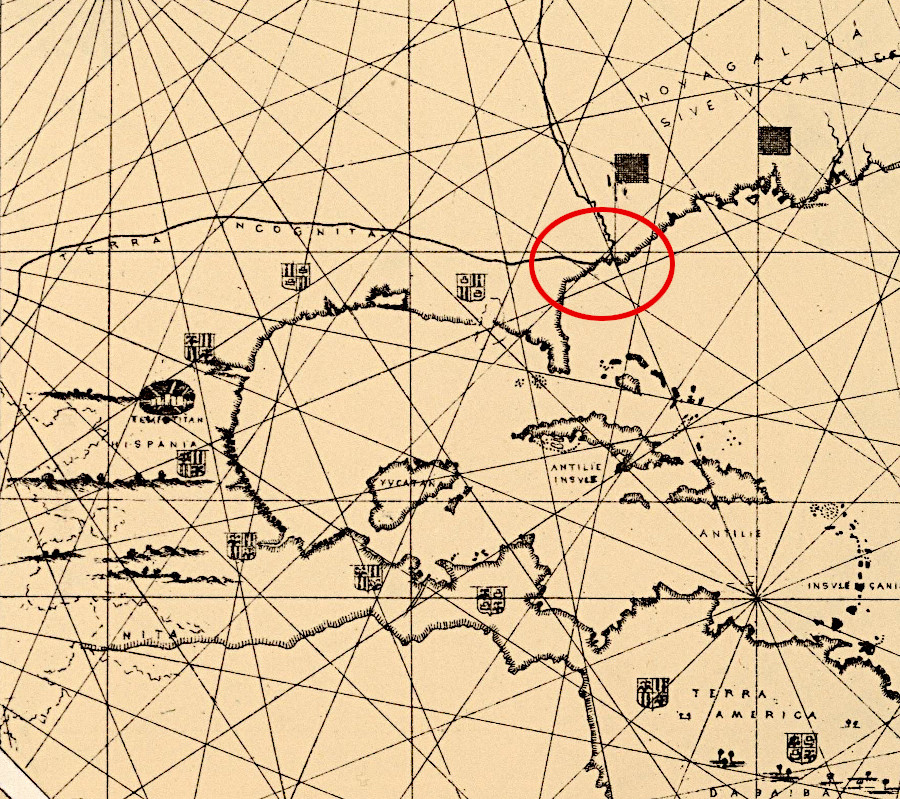
Verrazzano thought he saw the Pacific Ocean west of the Outer Banks, and that there was a narrow isthmus in North American similar to Panama
Source: David Rumsey Historical Map Collection, Plate 13 Facsimile Cartography 1492-1867. Verrazano Map, 1529
The French knew that Spanish settlement was focused on the major islands in the Caribbean, plus New Spain (Mexico) and the western side of South America (Peru). Starting in the 1530's, the French explored far to the north of the Spanish in the St. Lawrence River Valley. They started by fishing near Newfoundland and trading for furs.
Jacques Cartier led three expeditions, starting in 1534. His initial goal was to discover a passage to Asia.
In the Gulf of the St. Lawrence, he encountered people from the town of Stadacona (modern city of Quebec) who were fishing. Cartier took two sons of the local chief, Donnacona, back to France. They revealed the existence of the St. Lawrence River, and it's flow from the west.
Cartier returned the two sons when he sailed directly to Stadacona in 1535. He discovered that the people of Stadacona opposed his efforts to sail further upstream to Hochelaga (modern Montreal). From the very beginning of European contact, tribes along the Atlantic Ocean shoreline fought to control contact of inland tribes with the French, English, and Dutch. Cartier also angered the local residents by building a fort at the mouth of the Sainte-Croix River, now known as the Saint-Charles River.
King Francis I in Paris sponsored a major expedition in 1541 that was intended to establish a permanent colony. On his third trip Jacques Cartier sailed upstream to visit Hochelaga again. He discovered that the Lachine rapids in the St. Lawrence River blocked ships from going further upstream; there was no Northwest Passage to the Pacific Ocean.
In 1535 Cartier had started a settlement he named at St. Croix It was located across the St. Lawrence River from Stadacona. In 1541 he built Fort Charlesbourg-Royal for 350 colonists at the mouth of the Rivière du Cap-Rouge, on the north side of the St. Lawrence River just upstream of modern Quebec City.
In 1542 Cartier and the colonists who had survived the winter abandoned Charlesbourg-Royal. They sailed back to France in hopes that the shiny rocks he had collected were gold and diamonds. As was true for many mineral samples brought back to Europe in the 1500's and 1600's from North America, the rocks were common iron pyrite and mica/quartz. The phrase "as false as Canadian diamonds" became common after the value of Cartier's samples were determined.
Another 200 French colonists arrived in 1542 with the commander of the third expedition, Jean-François de la Rocque, Sieur de Roberval. He brought with him prisoners that had been released from jail in exchange for joining the expedition; they were not by nature obedient to his orders. As a Protestant, his authority over Catholics was also diminished. Roberval had to quash multiple attempted mutinies.
Cartier ignored orders from Roberval to join him and sailed home, rather than stay and support the new colonists. Roberval reoccupied Charlesbourg-Royal and suffered through a cold winter before he too abandoned the effort and brought everyone back to France in 1543. This time the French burned the fort to prevent possible re-use by the Spanish.3
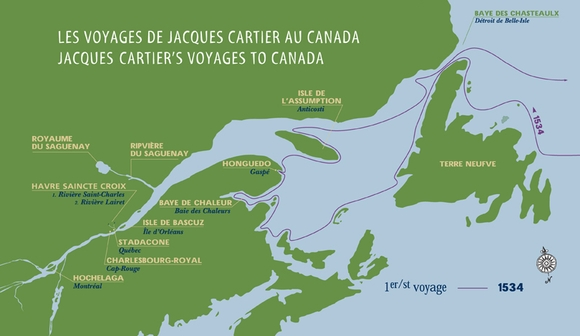
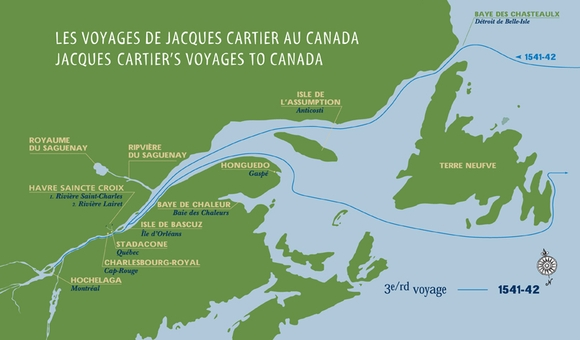
Jacques Cartier completed three trips to North America over 40 years before England tried to plant a colony there
Source: Cartier-Brébeuf National Historic Site, The second voyage (1535-1536); The third voyage (1541-1542)
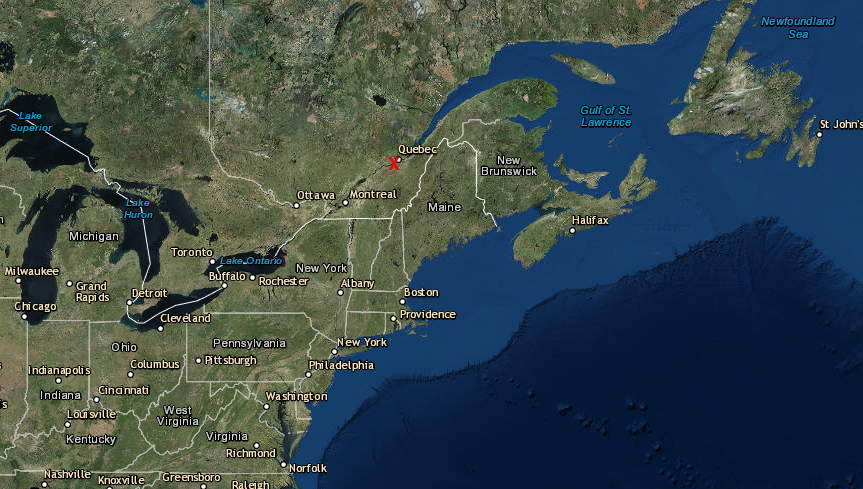
the first attempt by the French to start a colony in North America was in 1541 at Fort Charlesbourg-Royal, near where Quebec was founded in 1608
Source: ESRI, ArcGIS Online
Gaspard de Coligny, Admiral of France and leader of the French Protestants, sought to create a refuge for Huguenots in the New World. In 1555, the French took advantage of Portugal's failure to occupy all of the Brazilian coast and tried to settle at Guanabara Bay (now Rio de Janeiro). Poor leadership and internal tensions in the France settlement caused most colonists to return to France, and in 1560 the Portuguese captured it.
The French tried several times to occupy a site in South America, but ultimately concentrated on the St. Lawrence River and Mississippi River valleys. They started settlements at different places along the Gulf Coast plus the southeastern edge of North America, after Phillip II of Spain stopped further efforts to colonize North America in 1561. Tristan de Luna y Arellano's colony at Pensacola had failed, along with the plan to build an overland road to a Spanish base on the Atlantic Ocean coast at Punta de Santa Elena on the modern Florida-Georgia coastline.4
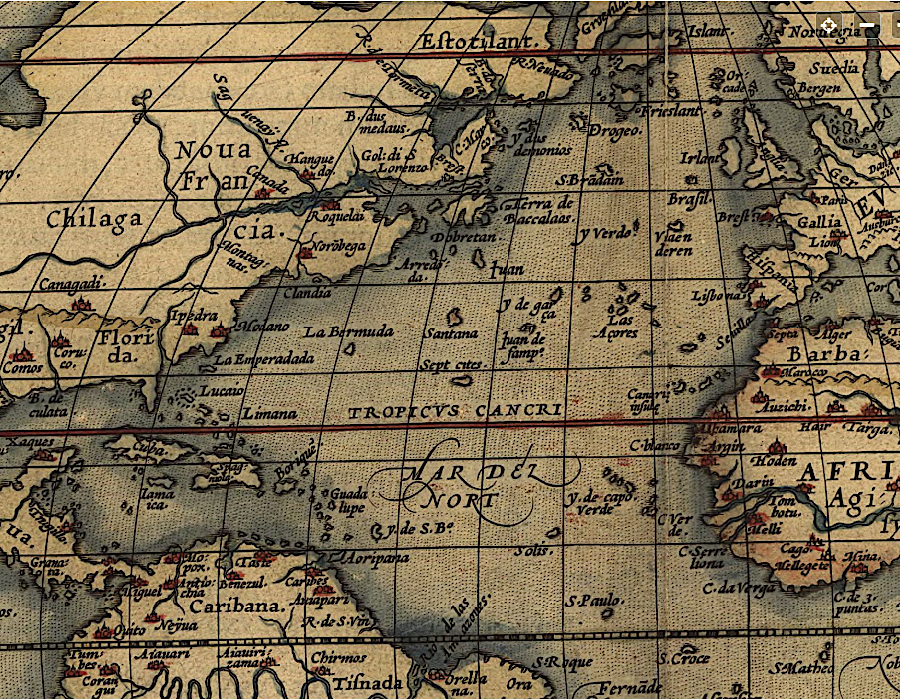
exploration of the St. Lawrence River led to the establishment of "New France" in North America
Source: Library of Congress, Theatrum orbis terrarum (by Abraham Ortelius, 1570)
When Spain halted plans for expansion into North America, the French responded by choosing a location on the Atlantic coast. They selected sites much further south than the St. Lawrence River, close to Hispaniola and other islands in the Caribbean that had been colonized by Spain since 1493.
In 1562, Gaspard Coligny de Châtillon sent Jean Ribault on an exploration of the southeast coast of North America. Coligny was a high official, the Admiral of France, but also a Protestant Huguenot. He anticipated the religious wars that were about to erupt in France as Catholics sought to repress the Huguenots. It was in the interest of the Protestants to find a refuge in North America. The Spanish had colonies on Caribbean islands and in Mexico (New Spain), but Florida was still unsettled.
Ribault explored what is now called the St. Johns River at Jacksonville, Florida, made friends with the local Timucuan tribe, and built a stone column to assert the French claim to the area on the southeastern edge of the North American continent.
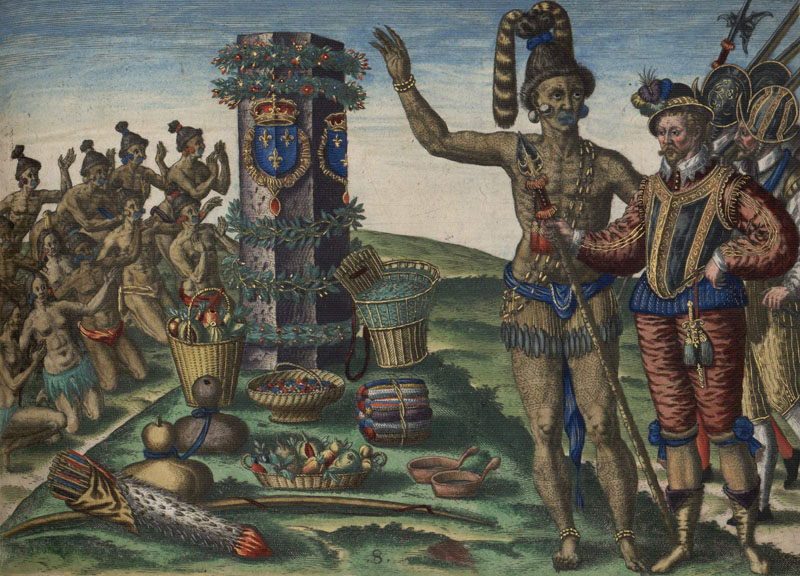
in 1562, the French built a stone column at what is now Jacksonville, Florida to assert their claim to land on the North American continent
Source: National Oceanic and Atmospheric Administration (NOAA), Historical Background Part I: French Colonization in Florida, 1562-1565
The French expedition in 1562 had not come with plans to start a colony; it was an exploratory visit without seeds, farming tools, or women. However, Ribault left 28 men at a place he named Charlesfort. Today, the site is part of the Marine Corps Recruit Depot on Parris Island in Beaufort, South Carolina.
Charlesfort was the second French attempt to establish a permanent colony in North America, after the 1541 attempt on the St. Lawrence River. Ribault's decision to build a fort and leave men behind may not have been part of the original plan. When leaving, he planned a quick return to France followed by re-supply of the colony. However, Catholic/Protestant warfare in Europe blocked his return to America.
Ribault was a Huguenot, a Protestant, while the French royal family was Catholic. The "Massacre of Vassy" occurred the same year as Charlesfort was settled. In France, open fighting started in an extended war of religion between French Protestants and Catholics. When Ribault sought assistance from Queen Elizabeth, a fellow Protestant, he ended up in an English prison rather than sailing back with supplies and reinforcements for his men at Charlesfort.
The settlers' life at Charlesfort was nasty, brutish, and short. The commander left by Ribault banished a soldier and left him to starve, but that triggered a mutiny and the killing of the commander. Recognizing that food would be inadequate for survival, the remaining colonists built a ship. Sailing back to France was not something Ribault had expected, and sails had to be manufactured from clothing. One person chose to remain behind at Charlesfort when all the rest of the French left in 1563.
The trip home across the Atlantic Ocean was as challenging as living at Charlesfort. After running out of food on the ship, the returning settlers selected one person on the ship and killed him for food. The unfortunate one was the soldier who had been left to starve. On the ship headed home, he ended up being eaten by his rescuers before they made contact with an English vessel near Ireland. The Spanish discovered the location of Charlesfort after it had been abandoned, burned the wooden walls and structures, and seized the one Frenchman remaining in North America.5
The French tried again after the 1562 Charlesfort settlement failed. In 1564 Rene Goulaine de Laudonniere led a three-ship expedition with 300 colonists back to North America. Rather than start again at Charlesfort, he chose to build Fort Caroline at the mouth of the St. Johns River in what is now Jacksonville, Florida.
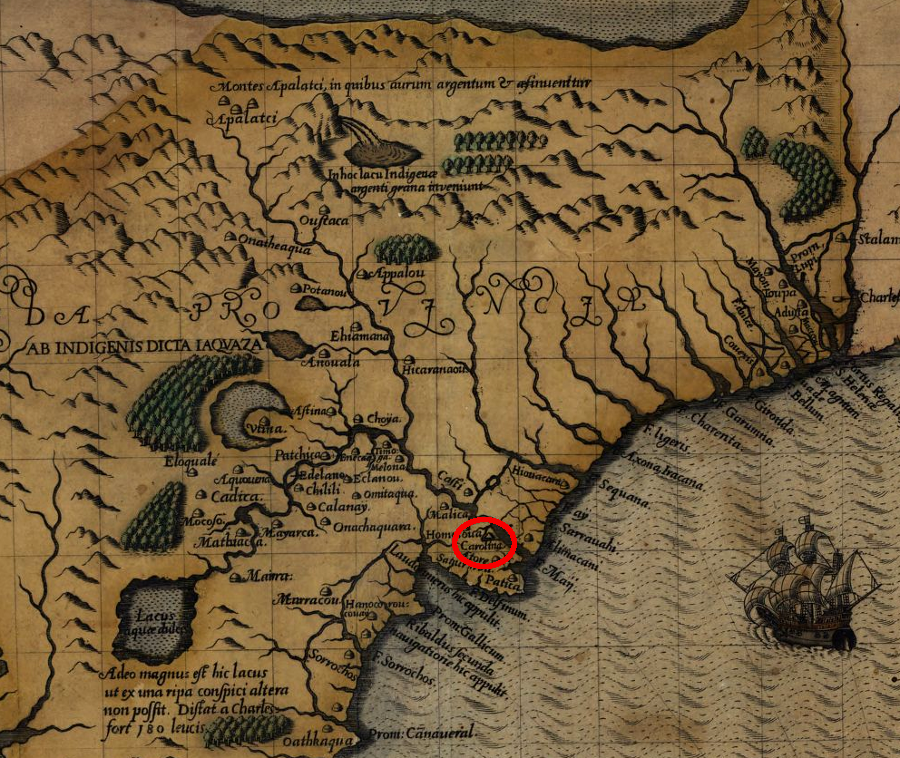
Fort Caroline (1564) was closer to the Spanish bases in the Caribbean than Charlesfort (1562)
Source: Library of Congress, Floridae Americae provinciae recens & exactissima descriptio auctore Iacobo le Moyne cui cognomen de Morgues (by Jacques Le Moyne de Morgues, published 1591)
That site was better protected from hurricanes, offered fresh water, and the Timucua Indians were friendly. On the downside, Fort Caroline was even closer than Charlesfort to the Spanish-controlled islands of Cuba, Hispaniola, and Puerto Rico in the Caribbean. There were no Spanish settlements on the mainland, but Spanish ships could blast the French with cannons and bring soldiers for a land attack.
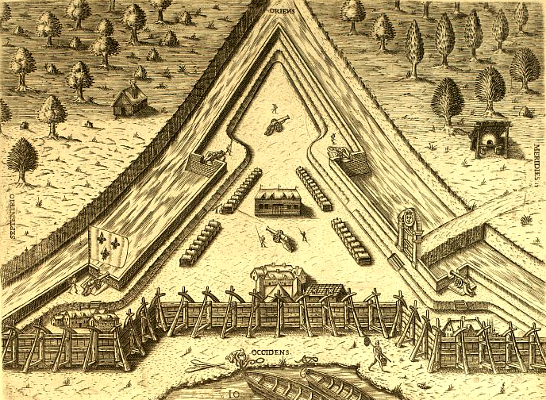
French colonists built Fort Caroline near modern-day Jacksonville (Florida) in 1564 - 43 years before the English built a similar triangular fort at Jamestown
Source: Exploring Florida, Le Moyne Gallery - Fort Caroline (Plate X)
Just as at Charlesfort, Fort Caroline was under-supplied. A faction mutinied, and de Laudonniere was forced to let them sail away with the food on a search for more supplies. An English fleet commanded Sir John Hawkins arrived later, and it provided food to the starving French in exchange for fresh water. The French exchanged cannons for one of the four English ships and planned to sail home, abandoning the fort.
Fort Caroline was partially dismantled to reduce its value to the Spanish, but before the French colonists sailed away a relief expedition under Jean Ribault arrived. In a pattern that would be repeated later in 1610 at Jamestown, an isolated colonial settlement at the edge of starvation was abandoning its one fort in North America - but new supplies arrived, just in time...6
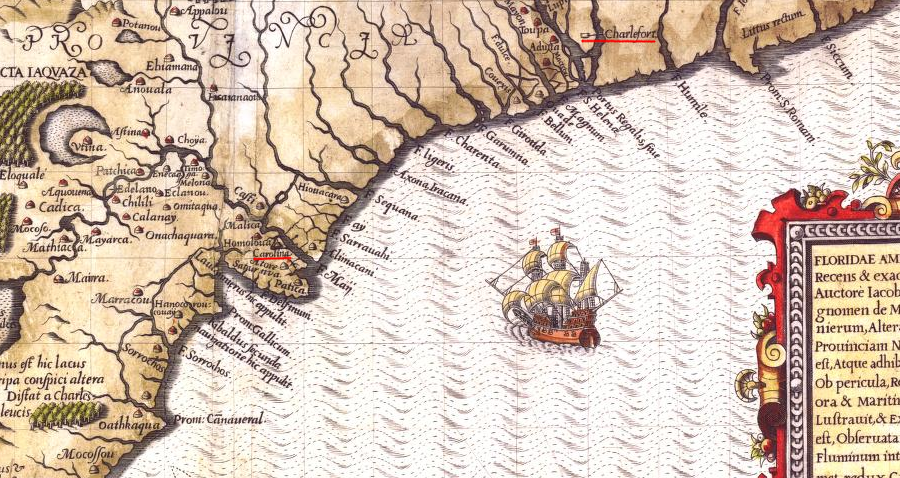
the French established Charlesfort first in 1562 and then Fort Caroline in 1564
Source: University of Alabama, Historical Maps of the Southeast Region, Floridae Americae Provinciae
After Ribault was released from an English prison, he brought 600 more soldiers and settlers in 1565. He arrived just before a Spanish force led by Pedro Menendez de Aviles.
Menendez landed his soldiers on the coast south of Fort Caroline, and Ribault sought to attack the Spanish Catholics before they could build a fortified base. The weather did not cooperate. The French ships were caught in a storm and wrecked.
Menendez immediately marched north despite the storm and destroyed the lightly-defended Fort Caroline, though de Laudonniere escaped. The Spanish found the shipwrecked French next and executed nearly all of them, including Jean Ribault, at what is now Fort Matanzas National Monument. Ribault's head was cut into four pieces, each one nailed to a post on the edges of St. Augustine.7
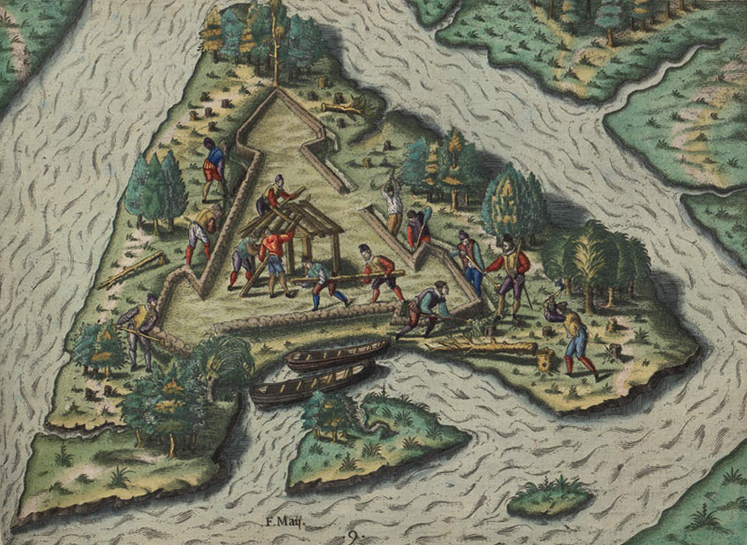
Fort Caroline was constructed in classic European style in 1564, but the Spanish under Pedro Menendez de Aviles captured it in 1565
Source: National Oceanic and Atmospheric Administration (NOAA), Historical Background Part I: French Colonization in Florida, 1562-1565

as late as 1685 the French were still asserting a claim to the Carolina coast
Map Source: Library of Congress, Amérique septentrion.lle [i.e. septentrionale] (by Jean Baptiste Louis Franquelin, 1685)
Lack of supplies, resistance by the local Native Americans, and direct attack by the Spanish quickly ended French attempts to settle on the southeastern coastline of North America. After failing at Charlesfort (1562) and Fort Caroline (1564), the French chose to settle again in Canada. The 1541 colony started by Jacques Cartier on the St. Lawrence River had lasted only two years, but intermittent fur trading had been profitable since then.
The French were successful in their efforts to settle the northern part of the North American continent, far from the Spanish in Florida, and establish New France.
In 1603, Henry IV gave Pierre Du Gua de Monts a 10-year monopoly over the fur trade between the 40-46th parallels, roughly from the mouth of the Delaware River north to the mouth of the St. Lawrence River. The charter for Acadia was the legal basis - in Frech eyes - for de Monts to start the "l'Acadie" at settlement St. Croix Island in Maine in 1604.
In 1605, after one very cold winter on that tiny island in which everything but the wine froze solid, he moved the colony to Port Royal on Nova Scotia. The French lasted two years there, with assistance from the Mi'kmaq. The European colonists returned to France in late 1607, after de Monts lost his monopoly over the fur trade. Later settlers established modern-day Annapolis at the site.8
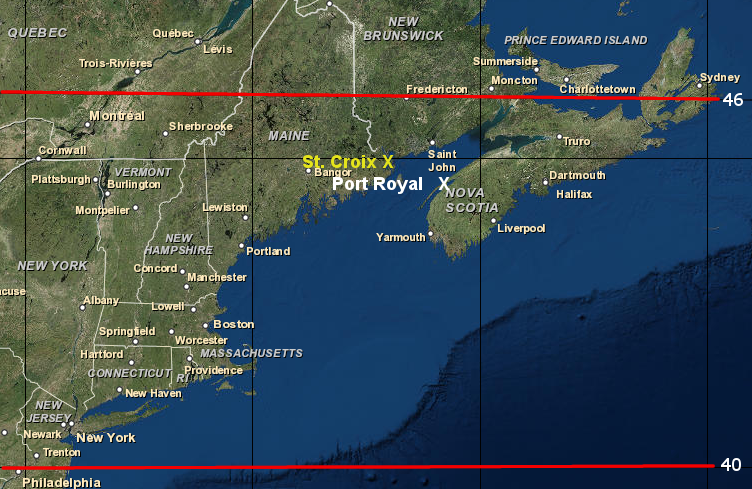
in 1603, Henry IV of France granted Pierre Du Gua de Monts a monopoly on the fur trade between 40-46 degrees latitude, leading to settlements at St. Croix and Port Royal
Map Source: ESRI, ArcGIS Online
Charlesfort and Fort Caroline provided a clear lesson to French and English settlers: the threat of Spanish attack was very, very real. That lesson shaped the location of colonial settlements attempted by both France and England.
In 1606, the Virginia Company directed the captains of the Susan Constant, Godspeed, and Discovery to sail upstream after reaching the Chesapeake Bay, and to establish their new English settlement far enough inland to provide sufficient time to defend against a surprise Spanish attack.
The first winter the English stayed at Jamestown in 1607-08, Spanish colonists had been living in Florida for over 40 years but there were no permanent French settlements in North America.
The French did return to North America again, and in 1608 established Quebec. That same year, the Spanish began their second permanent settlement in what today is the United States, starting Santa Fe in New Mexico.
French exploration westward into the interior of North America expanded faster than the English efforts. In 1654, when colonization in Virginia was just expanding west of the Fall Line into the Piedmont, French fur trader Medard Chouart, Sieur Des Groseilliers was traveling around the Great Lakes. In 1659-1660, he journeyed with his brother-in-law Pierre Esprit Radisson to what is now Wisconsin and Minnesota.
The first Europeans to travel through the Illinois country were adventurous French explorers, Catholic priests, and fur traders. In 1673 Father Jacques Marquette and Louis Joliet crossed from Lake Michigan to the Mississippi River, then canoed downstream to the Arkansas River. After determining that the Mississippi River provided a water highway from the Great Lakes to the Gulf Of Mexico, they turned back to avoid being captured by any Spanish ships sailing around the Caribbean.
Coming into the Mississippi River watershed from the north, Frenchmen walked, rafted, and canoed westward from Quebec and Montreal on the St. Lawrence River to trade with Native American groups. From the south, French explorers moved up from the Gulf of Mexico. In 1673 René Robert Cavelier, Sieur de La Salle, floated down the Illinois River to its confluence with the Mississippi River, then continued down south to the mouth. He named the territory Louisiana in honor of French king Louis XIV.
La Salle envisioned creating a chain of trading posts along the Mississippi River. In 1677 he obtained the rights from French officials in Paris to explore all the lands between Florida and Mexico. In 1683 he led a expedition of French and Native Americans down the Mississippi River to the site of modern-day Memphis. They build Fort Prud'homme there, then traveled to the mouth of the Mississippi River and buried a metal plate claiming the watershed as part of New France. On the expedition the French constructed Fort Saint Louis de Rocher on the Illinois River, as part of their effort to control the fur trade with various Native American nations who might otherwise deal with the English in New York.
In 1685 La Salle sailed on a journey from France to find the mouth of the Mississippi River. He overshot, landing eventually at Matagorda Bay on the Texas coast. La Salle died while still seeking the river's mouth.
In 1699 Louis XIV sent two brothers, Pierre Le Moyne d'Iberville and Jean-Baptiste Le Moyne de Bienville, to establish a settlement near the mouth of the river but far enough upstream to be safe from attack by the Spanish. New Orleans was founded in 1718, at a location which controlled all trade coming down the Mississippi River. Framce or Spain controlled New Orleans and threatened to throttle the economic potential of American farmers settling in the Mississippi River watershed until the Louisiana Purchase in 1803.9
The French claimed control over the Mississippi River and Ohio River watersheds based on their early "discovery" of that land. Until the end of the French and Indian War in 1763, the western edge of the Virginia colony - which had been occupied for about 20,000 years by Native Americans - was contested territory between France and England.
Many French immigrants to Canada melted into the Native American societies as fur traders. A coureur du bois ("runner of the woods") was a multilingual and multi-cultural entrepreneur, intermarrying with Native Americans and demonstrating great adaptability in adjusting to shifting requirements of European and Native American societies. The lives of the coureur des bois living in the backcountry were poorly documented, but their influence as cultural brokers allowed the French to control most of the trade of the Great Lakes, Ohio River, and Mississippi River watersheds.

French coureur des bois integrated into Native American society, in contrast to the unwillingness of English colonists to relinquish their European culture
Source: Sid Richardson Museum, The Courrier du Bois and the Savage (by Frederic Remington, 1891)
King Charles II chartered the Hudson's Bay Company in 1670 in hopes of gaining a percentage of the fur trade dominated by the French. Further south in Virginia, however, the English did not reach the Blue Ridge until John Lederer climbed the eastern slope in 1669-1670.
France ceded the Hudson Bay region to Great Britain in the 1713 Treaty of Utrecht, but retained all claims to the Mississippi River watershed. The end of the War of the Spanish Succession in 1713 can be used as a date to identify the steady rise of Great Britain, while France was losing its economic and military capacity to dominate relationships between different nations.
Governor Spotswood led the Knights of the Golden Horseshoe across the Blue Ridge to the Shenandoah River in 1716. He sought to spur settlement on the western edge of the colony so it would serve as a buffer against raids by Native Americans and potentially the French.10
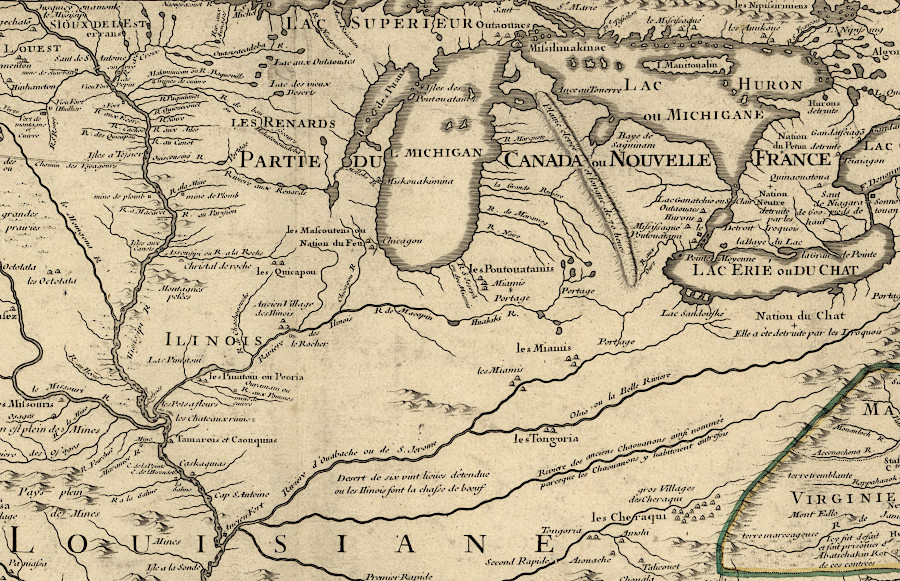
the French established their claim to all lands west of the Alleghenies before Governor Spotswood crossed the Blue Ridge with the Knights of the Golden Horseshoe in 1716
Source: Library of Congress, Carte de la Louisiane et du cours du Mississipi (by Guillaume de L'Isle, 1718)
The Native Americans on the east coast of North America were aware of how Fort Saint Louis had attracted bands to settle nearby. In 1689 a group of Delawares and Mahicans living on the Delaware River at Minisink (near the Delaware Water Gap) visited Fort St. Louis. They encouraged the Shawnee there to migrate east. By recruiting more people, the Delaware and Mahicans hoped to increase their capacity to resist efforts of the five confederated Iroquois tribes in New York (Haudenosaunee) to dominate the territory and trade all the way south to the Potomac River.
In 1692 some Shawnee made the trip to the Chesapeake Bay. A Frenchman, Martin Chartier, joined them after being part of a mutiny at Fort St. Louis. The Shawnee were welcomed by colonists and the Susquehannock, but Maryland officials initially jailed Chartier. The English feared attack by a French force:11
- In Pennsylvania rumors spread that an army of French soldiers and their Indian allies was marching to Maryland, where they would join with English Catholics and overthrow the Protestant governments, handing the colonies over to France.
Casparus Herrman, son of Maryland mapmaker Augustine Hermann, spoke in defense of Chartier. He was released and joined the Shawnee, who initially settled on Hermann's Bohemia Manor along the Elk River. By 1697 they moved westward to be near the Susquehannock town at Conestoga, and established a Shawnee town two miles away called Pequea.
Pennsylvania officials remained suspicious of Chartier, who was willing to sell furs to the French in Quebec when prices were higher there. In 1707 Chartier traveled south to Massanutten Mountain, searching with Franz Louis Michel for a silver mine.12

as late as 1685 the French were still asserting a claim to the Carolina coast
Source: Library of Congress, Amérique septentrion.lle [i.e. septentrionale] (by Jean Baptiste Louis Franquelin, 1685)
Links
- American Archeology
- Archeology
- Canada's Historic Places
- Canadian Museum of History
- Creighton University
- Early Caribbean Digital Archive
- Library and Archives Canada
- Library of Congress
- National Park Service
- Newberry Library
- Public Broadcasting System (PBS)
- University of South Carolina
- University of South Florida
References
1. Thwaites, Reuben Gold, "The Jesuit Relations and Allied Documents: Travels and Explorations of the Jesuit Missionaries in New France, 1610-1791 - Vol. III Acadia, 1611-1616," The Burrows Brothers, 1898, http://puffin.creighton.edu/jesuit/relations/relations_03.html (last checked August 2, 2015)
2. Schwartz. Seymour I., The Mismapping of America, University of Rochester Press, 2003, pp.45-47 http://books.google.com/books?id=ytxhjRNCeqkC&dq (last checked September 29, 2009)
3. "Long-lost Jacques Cartier settlement rediscovered at Quebec City," Montreal Gazette, August 19, 2006, http://www.canada.com/topics/news/national/story.html?id=4978e603-f67e-4784-807d-7f3911c60829; "Fort Charlesbourg Royal National Historic Site of Canada," Parks Canada, https://www.pc.gc.ca/apps/dfhd/page_nhs_eng.aspx?id=597; "The first voyage (1534)," Cartier-Brébeuf National Historic Site, https://parks.canada.ca/lhn-nhs/qc/cartierbrebeuf/culture/histoire-history/evenement-event/cartier/a; "The second voyage (1535-1536)," Cartier-Brébeuf National Historic Site, https://parks.canada.ca/lhn-nhs/qc/cartierbrebeuf/culture/histoire-history/evenement-event/cartier/b; "The third voyage (1541-1542)," Cartier-Brébeuf National Historic Site, https://parks.canada.ca/lhn-nhs/qc/cartierbrebeuf/culture/histoire-history/evenement-event/cartier/d; "Colonies and Empires - Founding Sites," Virtual Museum on New France, https://www.historymuseum.ca/virtual-museum-of-new-france/colonies-and-empires/founding-sites/; "Stadacona," The Canadian Encyclopedia, https://www.thecanadianencyclopedia.ca/en/article/stadacona; "La Rocque de Roberval, Jean-François de," Dictionary of Canadian Biography, https://www.biographi.ca/en/bio/la_rocque_de_roberval_jean_francois_de_1E.html (last checked May 28, 2025)
4. Margaret F. Pickett, Dwayne W. Pickett, The European Struggle to Settle North America: Colonizing Attempts by England, France and Spain, 1521-1608, McFarland, February 8, 2011, p.45, https://books.google.com/books?id=vTkyqDHcBvsC; Bill Marshall, France and the Americas: Culture, Politics, and History: a Multidisciplinary Encyclopedia, Volume 1, ABC-CLIO, 2005, pp.27-28,
https://books.google.com/books?id=jfq5Tp0nq98C; Christopher Allen, Daryl A. Ferguson, Andrew J. Beall, "Santa Elena and America's Lost Century," Santa Elena Foundation, May 25, 2015, pp.8-9, http://santa-elena.org/images/Santa_Elena_History.pdf (last checked April 20, 2016)
5. Harris, Sherwood, "The Tragic Dream of Jean Ribaut," American Heritage, October 1963, http://www.americanheritage.com/content/tragic-dream-jean-ribaut; John T. McGrath, "Admiral Coligny, Jean Ribault, and the East Coast of North America," French Colonial History, Michigan State University Press, Volume 1, 2001, http://msupress.org/journals/fch/; Richard Thornton, Fort Caroline, the Search for America's Lost Heritage, Lulu.com, 2014, p.45, https://books.google.com/books?id=Gx7zBgAAQBAJ; "Historical Background Part I: French Colonization in Florida, 1562-1565," National Oceanic and Atmospheric Administration (NOAA), http://oceanexplorer.noaa.gov/explorations/14lostfleet/background/history-pt1/history-pt1.html; "The Story of a Failed French Settlement in 16th Century North America: Charlesfort," History Is Now, May 31, 2020, https://www.historyisnowmagazine.com/blog/2020/5/31/the-story-of-a-failed-french-settlement-in-16th-century-north-america-charlesfort (last checked April 11, 2025)
6. Richard Thornton, Fort Caroline, the Search for America's Lost Heritage, Lulu.com, 2014, pp.46-50, https://books.google.com/books?id=Gx7zBgAAQBAJ (last checked April 22, 2016)
7. "History of Fort Caroline," Timucuan Ecological & Historic Preserve, Florida, National Park Service, https://www.nps.gov/timu/learn/historyculture/foca_history.htm; Andrew Lawler, The Secret Token: Myth, Obsession, and the Search for the Lost Colony of Roanoke, Doubleday, 2018, p.21, https://www.google.com/books/edition/The_Secret_Token/8yY0DwAAQBAJ (last checked October 25, 2020)
8. "The Legacy of Saint Croix Island," National Park Service, St. Croix Island International Historic Site, https://home.nps.gov/articles/000/legacy-of-saint-croix-island.htm; "Port-Royal National Historic Site," Tourism Nova Scotia, http://www.novascotia.com/see-do/attractions/port-royal-national-historic-site/1462;
Aubrey L. Haines, The Yellowstone Story, Volume 1, Yellowstone Library and Museum Association, 1977, p.30, https://www.google.bs/books/edition/_/TShVpwAACAAJ (last checked May 27, 2025)
9. "Radisson, Pierre Esprit (1636/1640–1710)," MNopedia, https://www.mnopedia.org/person/radisson-pierre-esprit-16361640-1710; Warren Hofstra, "Backcountry Frontier of Colonial Virginia," Encyclopedia Virginia, Virginia Humanities, December 7, 2020, https://encyclopediavirginia.org/entries/backcountry-frontier-of-colonial-virginia/; "Expedition of Marquette and Joliet, 1673," Wisconsin Historical Society, https://www.wisconsinhistory.org/Records/Article/CS520; "René Robert Cavelier, Sieur de La Salle: Life and Explorations," Texas Historical Society, August 3, 2020, https://www.tshaonline.org/handbook/entries/la-salle-rene-robert-cavelier-sieur-de; "The Founding of New Orleans," American Battlefield Trust, https://www.battlefields.org/learn/articles/founding-new-orleans;"The Explorers: René-Robert Cavelier de La Salle 1670-1687," Virtual Museum of New France, Canadian Museum of History, https://www.historymuseum.ca/virtual-museum-of-new-france/the-explorers/rene-robert-cavelier-de-la-salle-1670-1687/; "The History of Illinois' Fort St. Louis du Rocher (aka: Rock Fort) on Starved Rock," Digital Research Library of Illinois History, https://drloihjournal.blogspot.com/2018/07/history-of-illinois-fort-saint-louis-du-rocher.html; "The La Salle Expedition: A Journey into the Unknown," Texas State Historical Association, June 12, 2024, https://www.tshaonline.org/handbook/entries/la-salle-expedition (last checked May 27, 2025)
10. "Hudson's Bay Company," The Canadian Encyclopedia, https://www.thecanadianencyclopedia.ca/en/article/hudsons-bay-company; John Lederer, The discoveries of John Lederer, in three several marches from Virginia to the west of Carolina, and other parts of the continent: begun in March, 1669, and ended in September, 1670, together with a general map of the whole territory which he traversed, 1891, https://lccn.loc.gov/rc01002786; "Exploring the Knights of the Golden Horseshoe," Country Zest and Style, Fall 2020 , https://issuu.com/uncoveringthevalley/docs/cz_fall20_issuu/s/11108532; "War of the Spanish Succession," The Canadian Encyclopedia, https://www.thecanadianencyclopedia.ca/en/article/war-of-the-spanish-succession (last checked May 28, 2025)
11. "Cohongorooto: The Potomac Above the Falls - Archeological Identification and Evaluation Study of C&O Canal National Historical Park Rock Creek to Sandy Hook (Mile Markers 0 To 59), Volume I," National Park Service, December 2005, p.59, https://www.whilbr.org/sites/default/files/2023-03/Archealogical_Identification_RockCreek-Sandy_Hook2.pdf (last checked March 31, 2025)
12. "Cohongorooto: The Potomac Above the Falls - Archeological Identification and Evaluation Study of C&O Canal National Historical Park Rock Creek to Sandy Hook (Mile Markers 0 To 59), Volume I," National Park Service, December 2005, pp.63-64, https://www.whilbr.org/sites/default/files/2023-03/Archealogical_Identification_RockCreek-Sandy_Hook2.pdf (last checked March 31, 2025)

in 1702, the French claimed Nouvelle France extended to the head of the Chesapeake Bay, including the Susquehannock territory
Source: New York Public Library, Le Canada, ou Nouvelle France, la Floride, la Virginie, Pensilvanie, Caroline, Nouvelle Angleterre et Nouvelle Yorck, l'Isle de Terre Neuve, la Louisiane, et le cours de la riviere de Misisipi (Nicolas de Fer, 1702)
Exploring Land, Settling Frontiers
Virginia Places

















